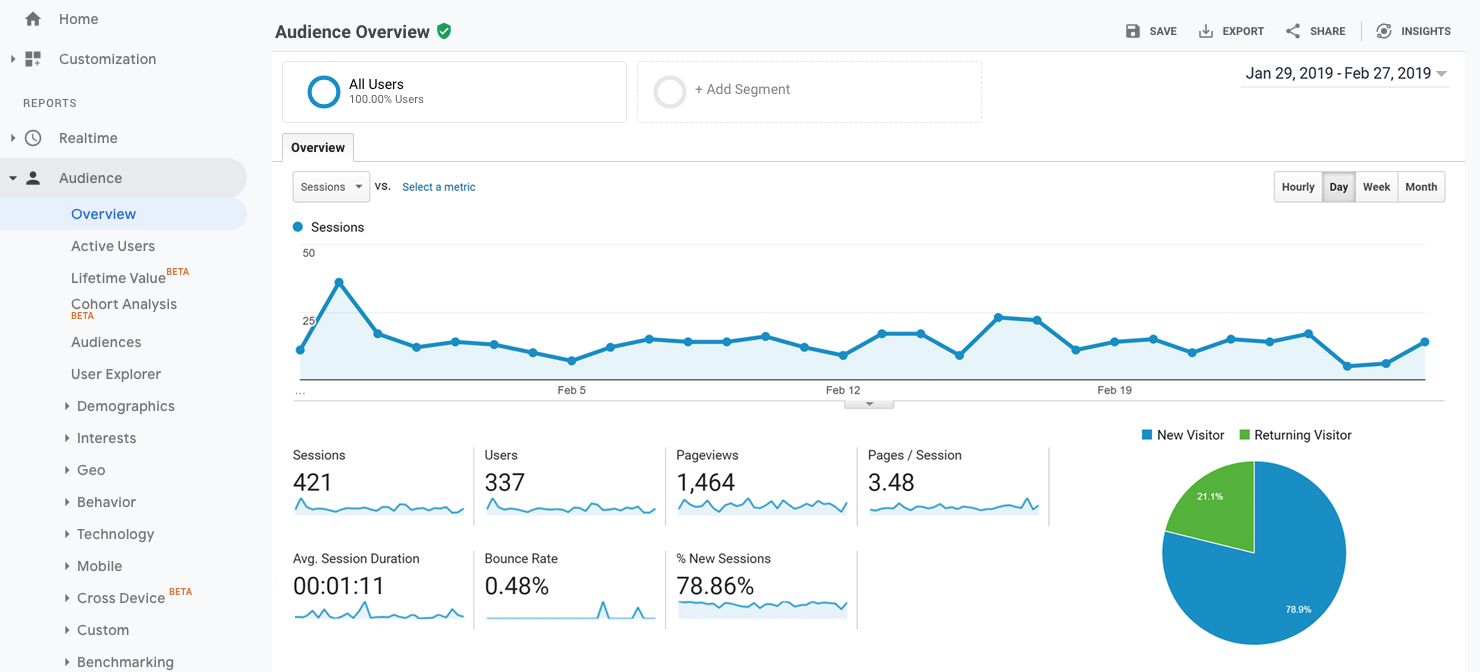Identifying a Target Audience for Your WordPress Blog

Whether you’re just starting a new blog or you’re working on your regular weekly content, it’s important to have a clear understanding of who your target audience is. So yes, even if you’ve been writing blog posts up until this point without an audience in mind, there’s no time like the present to figure it out and build a cohesive plan for how you put content out into the world.
We’ll begin here today by offering up the what and why of the target audience concept. And from there, we’ll discuss how to determine the appropriate one for your blog as well as offer up a few helpful tools for getting a handle on this information.
Let’s jump in.
What Is a Target Audience?
To put it simply, the target audience of your blog is for whom you’re creating content. When you close your eyes and picture the person reading your blog then subsequently making a purchase or subscribing to your email newsletter, what do you see? A mom in her thirties? A college student? A retiree? Having a solid understanding of who you’re writing content for can largely drive how you approach content creation. It informs the topics you’ll cover as well as the tone and style.
To get even more specific, a target audience refers to a group of people that are bound together by specific demographic information and behavior. Common demographic info that’s used to inform target audiences include age, gender, location, income, education, marital status, profession, and whether or not they have kids.
With that definition out of the way, let’s now explore why you need to know this information in the first place.
Why Do I Need to Know My Target Audience?
Good question! With this information in hand, you can make better decisions about how you write your content. If you know who you’re writing for, that can greatly inform everything from the tone of voice you write in, the vocabulary you use, the pop culture references you lean on, and so forth. Basically, knowing your audience means writing more precise content that better speaks to those you’re wanting to reach.
How to Identify a Viable Target Audience

In order to identify those that would most benefit from your content, service, product, or all of the above, you need to think in specific terms. And that means asking yourself some questions.
Do Some Deep Thinking
First thing’s first, put on your thinking cap. What does your product or service provide? What problems does it solve and what pain points does it meet? This is something you need to know to approach all of your marketing efforts properly.
Your goal here is to identify who your product or service is intended for. If you sell baby strollers, then your target demographic is likely women between the ages of 25-40. Knowing this would help you craft content that speaks to their needs directly. The same goes if you offer investment planning services. Ask yourself, who would these services help the most? And the answer to that identifies your target audience.
Evaluate Your Competitors
Your next step is to take a look at what your competitors are doing. This can be as simple as going directly to competitor websites and seeing how they write content. What tone do they use? What sorts of calls-to-action? How do they interact with people on social media? Mimicry (but not copying) in this way can be really helpful as you establish your own little corner on the web.
You can also search commonly used hashtags for your industry on the popular social media platforms. What are people saying? What are they sharing? What are you competitors doing in this space? Be prepared to take lots of notes. This information can be gold if leveraged well.
Evaluate Analytics
Analytics can tell you a lot about your target audience as well. In this way, it can be sort of helpful to have had a site for a bit as you can use the data collected to make better decisions about how you target your content in the future. It also goes to show that there’s never a time where you can’t be improving your targeting efforts.
Google Analytics, specifically, is invaluable here, as it can provide detailed reports that contain demographic details about who has been visiting your blog already. With it, you can view the age, gender, and location of those who have visited. This will also allow you to view social media stats about who is interacting the most with your posts as well as the time of day that garners the most traction.
Another word about social media: evaluating the analytics or insights data from social networks can give you a varied look at the type of people who interact on each platform as well. Different sorts of people will interact with your blog content across each network.
For instance, older people tend to interact on Facebook more. Twitter usually has a younger audience. Instagram is a mixed bag. But delving into your analytics here will give you a sense of who’s interacting with your posts, who clicks through to your blog, what people like most, what types of posts work best, and so forth. Basically, this can give you a near-constant state of affairs regarding your blog and business and allow you to always adapt and adjust your marketing strategy (and your content strategy) to meet the ever-evolving needs of your audience.
Create Buyer or Reader Personas
Once you’ve gathered a good amount of data about your target audience, you can begin to develop reader personas. This is pretty much the same thing as a buyer persona, only for blog readers rather than customers. The two may intersect greatly, but I digress.
Developing a reader persona involves using the information you know about who reads your blog and catering your content to that individual. And to be more specific, it means thinking about how your content can solve the problems your readers face as they’re browsing through your blog’s content. Often, the reader persona and buyer persona will be one in the same, especially since blogs are used with great frequency as a supplement to e-commerce stores or digital media shops.
Once you’ve collected competitor research and seen how your readers interact on social media, you can create a little write up reader persona. So, if you have a website that sells knitting patterns and a blog to support that endeavor that offers up knitting tips and tricks, a reader persona might be “Knitty Nina, a mom who wants quick project ideas she can complete while watching TV” and your blog content can then be centered around fulfilling this person’s needs.
You may find that you need to create more than one reader persona, as more than one “type” of person visits your blog. This leads us to our next section:
What If I Have More Than One Target Audience?
Sometimes, this happens! And it’s perfectly okay. The more you dig into the details of who reads your blog, the more you’ll learn that you might need to write for more than one type of persona. This will mean creating profiles or reader personas for multiple people. So, you’ve fleshed out the persona for “Knitty Nina,” already. But you might also have “Purl Pearl,” a grandma who loves complex patterns and lacework and needs tutorials and ideas in that vein. Or what about “Knit-Together Ned,” a guy that’s picked up a knitting hobby and likes to make accessories to donate?
While it might not be practical to create content for all of these personas (especially if they fall outside your overall niche) it can be beneficial and even lucrative to do so, especially if you find these sorts of folks are already visiting your blog. Imagine how much more valued, appreciated, and cared for they’ll feel if you begin creating content specifically for them? With this kind of effort, readers are much more likely to become subscribers, regular visitors, and even customers.
Tools to Find Your Target Audience

We’ve actually mentioned a few of the tools you’ll need in passing already but here’s a handy list of tools that make identifying your target audience a snap.
Google Analytics
Google Analytics will prove invaluable as you work to identify a target audience for your blog. As we already discussed, you can use it to delve into the details about how people interact with your content, what posts resonate the most, what gets shared, as well as discover demographic information. It’s essential, and with the Google Site Kit plugin you can even access your report right from your WordPress Dashboard.
Facebook Insights
Social media analytics or insights will also be a vital resource here. Facebook Insights can tell you detailed demographic info. But you should dig into the details of how all of your social accounts are performing. Twitter Analytics is available to anyone using the platform. Detailed analytics are also available for those with Professional accounts on Instagram. Use what’s given to you for free before doling out cash for a subscription-based analytics service. You’d be surprised by how much information you can glean for free.
VerticalResponse
VerticalResponse is a survey service that allows you to gather feedback from your target audience in real-time. You can send these surveys to those who’ve subscribed to your blog already to gather information about what sorts of content they’d like to see. You can ask them to rate your existing content and basically get their opinions about anything related to your blog.
Hopefully, you now have a clearer understanding of what it takes to identify your blog’s target audience. The tips included here showcase just how important having this information is as well as provides a detailed look at how to find it for yourself. Whether you’re researching competitors or doing some listening on social media, one thing remains certain: the information you gather is priceless.




Comments
No comments yet. Why don't you kick off the discussion?